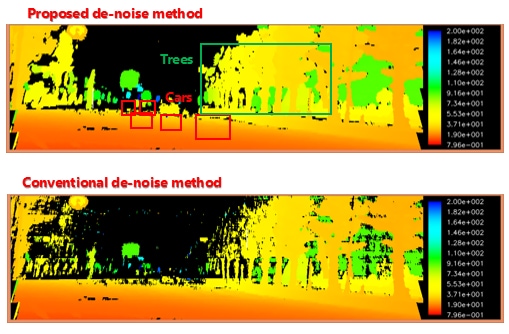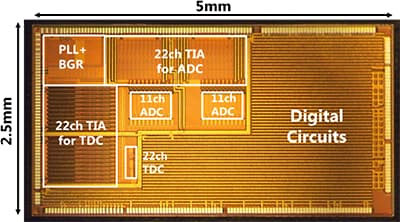Toshiba Electronic Devices & Storage Corporation’s Technology Improves Reliability of Long-Range and High-Pixel Resolution Automotive LiDAR
April 19, 2018
Toshiba Electronic Devices & Storage Corporation
TOKYO--Toshiba Electronic Devices & Storage Corporation has developed a new logic technology that significantly improves on the reliability of automotive LiDAR by realizing long-range distance object measurement and high quality 3D images. Used in combination with circuit technology announced by Toshiba Corporation on March 5,[1] the new technology improves the maximum measurable range by about 1.8x on 99% of denoised results, compared with the current approach.[2] Details of the technology will be announced at COOL Chips 21 held in Yokohama on April 20.
LiDAR systems that use laser-based light detection and ranging detect surrounding vehicles and pedestrians more precisely than any other sensors, and are a key technology for self-driving vehicles. To be effective, automotive LiDAR systems must deliver long-range distance measurements and high resolution images.
Long-range measurement in bright sunlight is a particular challenge for LiDAR, as the conditions generate a lot of noise. An averaging algorithm using multiple pixel data can suppress noise, but current averaging algorithms degrade pixel resolution when multiple objects exist within the the LiDAR operating range. They also generate multiple data returns that include false data related to random noise, which can occur when no object exists within the measurable distance.
While data selection and de-noising can be applied in post-processing, applying the averaging algorithm produces a side effect, range-value clustering. The clustering occurs due to averaging with random noise, which prevents the random noise from appearing as outlying data. Denoising is difficult without loss of the true signal.
Although Toshiba Corporation developed a hybrid circuit and a smart averaging technique that together realize long-range distance measurement and detection of small objects[1], there was room for improvement in eliminating range-value clustering. Toshiba Electronic Devices & Storage Corporation took on that challenge. By applying its know-how in semiconductor circuitry and optoelectronics, the company found that the reliability of data could be expressed by using only cluster size and luminance intensities, and developed a new algorithm that performs denoising based on the reliability of distance results.
The algorithm successfully remove noises and eliminates the effects of range-value clustering. Simulation results have found that the combination of Toshiba Corporation’s technology and the algorithm improves the maximum measurable range by about 1.8x on 99% of de-noised results. This achieves early recognition of other vehicles or obstructions when driving on a highway, and reduces the chance of overlooking a pedestrian while driving in urban areas. Moreover, the overhead of the hardware implementation is small, 1% or less, in respect of silicon area and power consumption.
Toshiba Electronic Devices & Storage also develops Silicon Photo-Multipliers (SiPM), high-sensitivity integrated optical sensors for LiDAR systems. The company will enhance its product lineups for automobile LiDAR systems by delivering SiPM and LSIs with the new algorithm.
Toshiba Electronic Devices & Storage will continue research into improving ranging accuracy and aim to establish a practical technology by fiscal year 2020. The company will also continue to promote R&D in autonomous driving systems, and is committed to delivering automotive semiconductor solutions that further advance safe driving.
Notes
[1] Toshiba’s New Circuit Technology Realizes Long-Range and High Resolution LiDAR (Light Detection and Ranging) for Reliable Self-Driving Vehicles
http://www.toshiba.co.jp/about/press/2018_03/pr0501.htm
[2] Based on simulations conducted by Toshiba Electronic Devices & Storage Corporation in March 2018



Information in this document, including product prices and specifications, content of services and contact information, is current on the date of the announcement but is subject to change without prior notice.